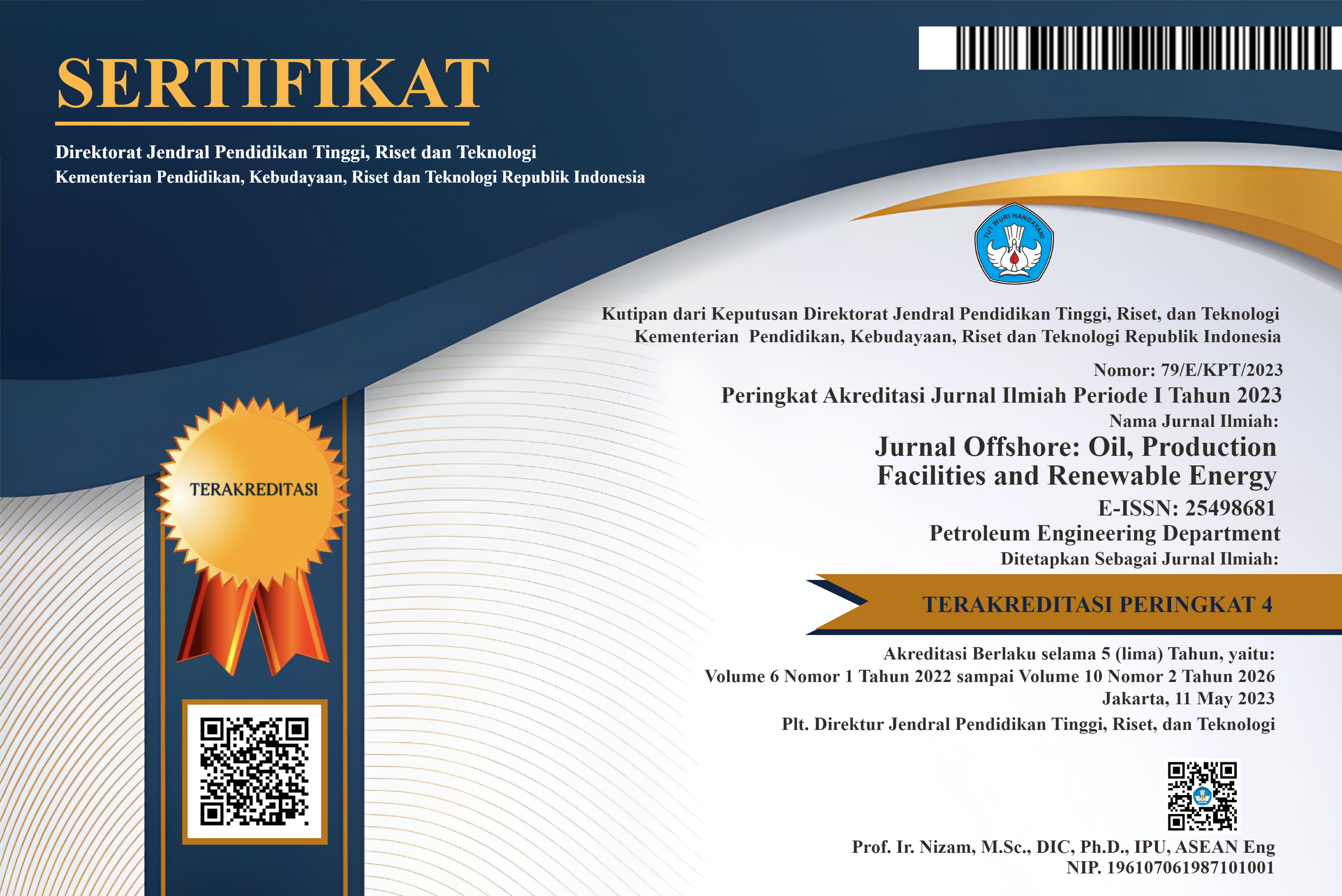STUDI POTENSI BATUAN INDUK HIDROKARBON SATUAN BATULEMPUNG FORMASI RAMBATAN DAERAH WANGON SUB-CEKUNGAN BANYUMAS
DOI:
https://doi.org/10.30588/jo.v4i1.719Abstract
Identifikasi interval batuan yang mungkin memiliki potensi sebagai batuan induk adalah langkah pertama yang penting dalam eksplorasi hidrokarbon, oleh karena itu perlu dilakukan penelitian tentang batuan sedimen yang mengandung bahan organik dengan tingkat pemanasan dan waktu tertentu dapat menghasilkan hidrokarbon dalam bentuk minyak atau gas. Tujuan dari penelitian ini adalah untuk mengidentifikasi fasies batuan dan potensi batuan induk hidrokarbon dari Satuan Batulempung Formasi Rambatan di Wilayah Wangon, Sub-Basin Banyumas. Berdasarkan data singkapan menunjukkan bahwa Formasi Rambatan di daerah penelitian sebagian besar terdiri dari serpih dengan interkalasi tipis batupasir. Formasi ini diendapkan di lingkungan laut dalam oleh arus turbid. Analisis geokimia untuk menentukan potensi dan kualitas batuan induk dilakukan pada empat sampel (BMS-28, KLP-27, KLP-31 dan BMS-120) serpih Rambatan. Analisis kualitas potensial dan sumber batuan menunjukkan konten TOC bervariasi dari 1,21% - 23,45% menunjukkan kualitas "sangat baik". Analisis Rock-Eval menunjukkan bahwa serpih dari sampel BMS-28 dan BMS-120 buruk sebagai batuan sumber hidrokarbon (S2 <2,5 kg / ton), sedangkan serpih dari sampel KLP-27 dan KLP-31 memiliki potensi yang baik sebagai batuan induk hidrokarbon (S2> 5 kg / ton). Semua sampel yang diambil dari Serpih Rambatan menunjukkan Ro <0,6 menunjukkan tingkat pematangan hidrokarbon belum tercapai. Nilai rendah HI BMS-28 dan BMS-120 (HI <100 mg HC / g TOC), mencerminkan bahwa batuan ini dapat diklasifikasikan sebagai batuan non-sumber, sedangkan sampel KLP-27 dan KLP-31 memiliki nilai HI 152 mg HC / g TOC dan 294 mg HC / g TOC akan cenderung menghasilkan gas dan minyak jika mencapai tingkat kematangan. Nilai HI antara 100-300 mgHC / g umumnya berasal dari tipe III dan II kerogen yang sebagian besar mengandung organisme darat dan laut.
Kata kunci: batuan induk, potensial, kualitas, dan kematangan
ABSTRACT
Identification of rock intervals that may have as a source rock potential is the important first step in hydrocarbon exploration, therefore it is necessary to conduct research on the sedimentary rock containing organic matter which with a certain level of heat and time can produce hydrocarbons in the form of oil or gas. The objective of this study is to identify lithofacies and hydrocarbon source rock potential of Claystone Unit of the Rambatan Formation in the Wangon Area, Banyumas Sub-Basin. Based on outcrop data showed that Rambatan Formation in the study area predominantly composed of shale with thin intercalation of sandstones. This formation was deposited in the deep marine environment by turbidity current. Geochemical analysis in order to determine the potential and quality of source rock was performed on four samples (BMS-28, KLP-27, KLP-31 and BMS-120) of Rambatan shale. The analysis of potential and source rock quality showed TOC content varied from 1.21% - 23.45% indicating “very good” quality. Rock-Eval analisys show that the shale from sample BMS-28 and BMS-120 are poor as hydrocarbon source rock (S2<2.5 kg / ton), while shale from samples KLP-27 and KLP-31 have good potential as hydrocarbon source rock (S2>5 kg / ton). All samples taken from Rambatan shale showed Ro <0.6 indicate hydrocarbon maturation level has not been reached. The low values HI of BMS-28 and BMS-120 (HI<100 mg HC / g TOC), reflects that this rock can be classified as non-source rock, while samples KLP-27 and KLP-31 have HI values of 152 mg HC/g TOC and 294 mg HC/g TOC will tend to produce gas and oil if it reaches maturation level. The values of HI between 100-300 mgHC/g are generally derived from type III and II kerogen which predominantly contain terrestrial and marine organism.
Keywords: source rock, potential, quality, and maturity
References
Djuri. M,. Samodra,H., Amin, T.C., dan Gafour.S., 1996. Peta Geologi Lembar Purwokerto, Jawa, Skala 1:100.00, Pusat Penelitian dan Pengembangan Geologi, Bandung.
Kastowo dan Suwarna, N., 1996, Geologi Lembar Majenang, Jawa, Skala 1:100.000. Pusat Penelitian dan Pengembangan Geologi, Bandung.
Bordenave, M. L. (ed.), 1993. Applied Petroleum Geochemistry. Editions Technip, France, 524pp.
Asikin, S., Handoyo,A., Prastistho, B., Gafour, S., 1992. Peta Geologi Lembar Banyumas Jawa,Skala 1:100.000, Pusat Penelitian dan Pengembangan Geologi, Bandung.
Walker, Roger G., James, Noel P., 1992. Facies Models Response To Sea Level Change, Geological Association of Canada, Canada.
Peters, K.E., 1986. Guidelines for evaluating petroleum source rock using programmed pyrolysis. American Association of Petroleum Geologists, Bulletin, 70, p.318-329.
Waples, D.W., 1985. Organic Geochemistry for Exploration Geologist. International Human Resources Development Corp., Boston, 232 h.
Tissot, B.P. dan Welte, D.H., 1984. Petroleum Formation and Occurrence, Edisi Kedua, Springer-Verlag, Berlin, 699 h.
Downloads
Published
How to Cite
Issue
Section
License
Authors retain copyright and grant the Jurnal Offshore right of first publication with the work simultaneously licensed under a Creative Commons Attribution 4.0 International License that allows others to share (copy and redistribute the material in any medium or format) and adapt (remix, transform, and build upon the material) the work for any purpose, even commercially with an acknowledgement of the work's authorship and initial publication in Jurnal Offshore. Authors are able to enter into separate, additional contractual arrangements for the non-exclusive distribution of the journal's published version of the work (e.g., post it to an institutional repository or publish it in a book), with an acknowledgement of its initial publication in Jurnal Offshore. Authors are permitted and encouraged to post their work online (e.g., in institutional repositories or on their website) prior to and during the submission process, as it can lead to productive exchanges, as well as earlier and greater citation of published work (See The Effect of Open Access).















